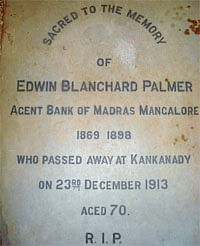
It is a well known fact that the undivided Dakshina Kannada district is the home of banks. In fact, 4 nationalised banks — Corporation Bank, Canara Bank, Syndicate Bank and Vijaya Bank (and also Karnataka Bank Limited, a private sector bank) were established in the district.
But, much before these banks were established in the coastal region, the British government opened a branch of the Bank of Madras in Mangalore on October 1, 1869.
It catered mainly to British officers and reputed merchants of Mangalore and also to wealthier native industrialists such as Alex Albuquerque Pai, Simon Alvares (both parishioners of the Rosario Cathedral, who were the leading tile-industrialists of the period) and Nellikai Venkata Rao (a leading exporter of spices and coffee), in whose memory a road beside the State Bank of India building has been named as “Nellikai Venkatrao Road” which leads to Bunder.
First agent
Edwin Blanchard Palmer was the first agent of the Bank of Madras in Mangalore (1869-1898), who opened the branch on October 1, 1869, at an young age of 26 years and served in Mangalore as the Agent untill 1898, a dedicated service of 29 years in Mangalore.
Interestingly, even after his retirement, he did not return to his native England. He lived for about 15 years in Mangalore after his retirement and died on December 23, 1913, at the age of 75 years.
His epitaph is still there inside Rosario church and is a mute witness to the great personality who once fulfilled the banking needs of Mangaloreans.
Recalling the history, Michael Fernandez, a retired manager of State Bank of India (SBI), said that a portrait of Edwin Blanchard Palmer in oil paint used to adorn the SBI branch manager’s chamber, but sadly, the portrait has vanished.
“The last time I saw his portrait was in 1980 when A S Pattabiraman was the branch manager,” he said and added that his appeals to the persons concerned have fallen on deaf ears.
On the other hand, there is a board in the main hall displaying that the Bank was opened on October 1, 1869, but does not mention anything about E B Palmer. The list of names who served as managers begin from 1965, which is well after 95 years since Palmer opened the branch.
When contacted, SBI present AGM C M Thallur said that he is not aware of the oil painting.
“A lot of renovation work is going on and attempts will be made to include details on E B Palmer,” he said.
Holi, Kuri, Hundi...
In those days, there was a system of giving loans known as ‘Holi’ under which a tenant approached a money-lender and borrowed rice which he undertook to pay back after the harvest was over by giving 14 seers (one kalasige) more for every 42 seers (one moora/mudi) of rice borrowed.
There was a system called ‘Kuri’ under which a number of people subscribed to a fund and the amount so raised would be given to the highest bidder, the bid amount being then divided equally among the members of the Kuri scheme.
The third system was ‘Hundi’ which is a written promise to pay a certain sum of money to a certain person or bearer on demand or on a specified date (promissory note).
Roots of banks
It is interesting to know the roots of 4 oldest nationalised banks which were established in undivided Dakshina Kannada district.
The Corporation Bank (initially known as Canara Banking Corporation Limited, Udupi) was established on March 12, 1906 by Khan Bahadur Abdullah Haji Kasim Saheb Bahadur. He was the president of the bank from 1906 to 1929. In fact, the Corporation Bank was the first bank to be established in South Canara with Udupi as its base. During this period, well known merchants, brokers and commission agents were Muslims and Abdullah was a respected representative of this community possessing keen insite and a lot of financial clout. Gowda Saraswat Brahmins (GSBs) who belonged to the versatile trading community were also responsible for the growth of banking in South Canara.
In the same year (1906), another philanthropist Ammembal Subbarao Pai started Hindu Permanent Fund Limited at Dongarakeri in Mangalore, which was renamed as Canara Bank Limited in 1910. Pai was its founder President. Then followed Canara Industrial and Banking Syndicate Limited (Syndicate Bank) founded by Upendra Ananth Pai (businessman), Vaman Srinivas Kudva (engineer) and Dr T M A Pai (physician) in Udupi. Yet another nationalised bank, Vijaya Bank, was established by Attavara Balakrishna Shetty at Bunts Hostel in Mangalore in 1931. Since it was established on Vijayadashami Day, it was named ‘Vijaya Bank.’
Meanwhile, the prestigious private sector bank, Karnataka Bank Limited, was established on February 18, 1924.
Pre - banking era
When transport was not freely accessible, farmers used to bring their produce for sale in Mangalore by means of bullock-carts, country crafts (boats) and after the completion of the sale, they normally used to purchase their household requirements and the surplus funds used to be deposited with merchants/landlords of repute and proven honesty who maintained separate books of account individually for each farmer and this amount was kept interest-free for custody, as carrying large amounts exposed grave risks from thieves and burglars on their way to their respective villages.
Interestingly, some enterprising merchants/commission agents started paying the farmers a nominal rate of interest on their deposits and also provided them with farm implements and necessary agro based manure for their crops.